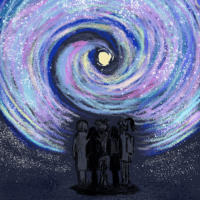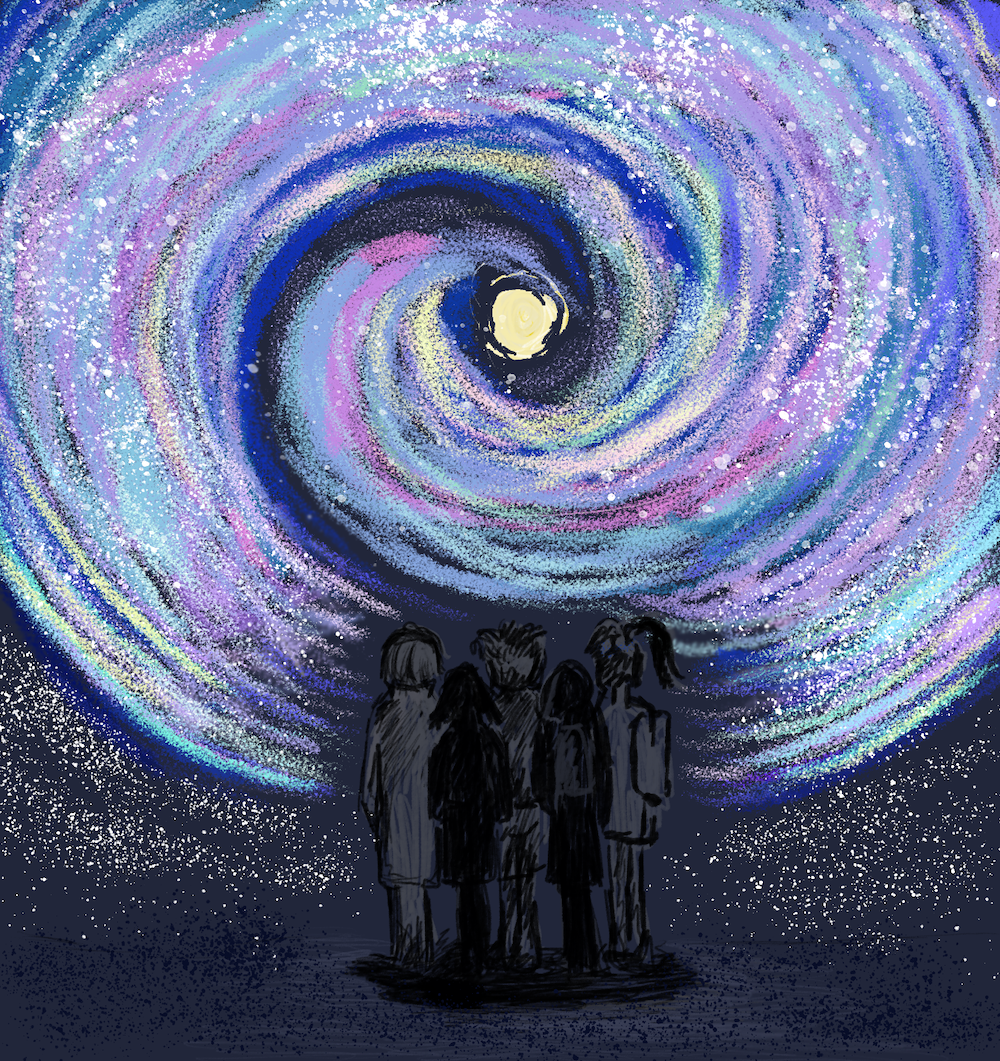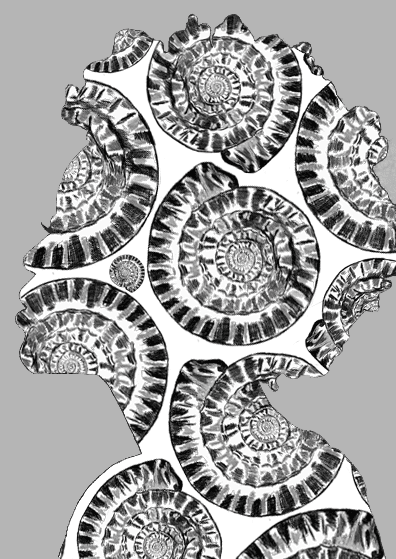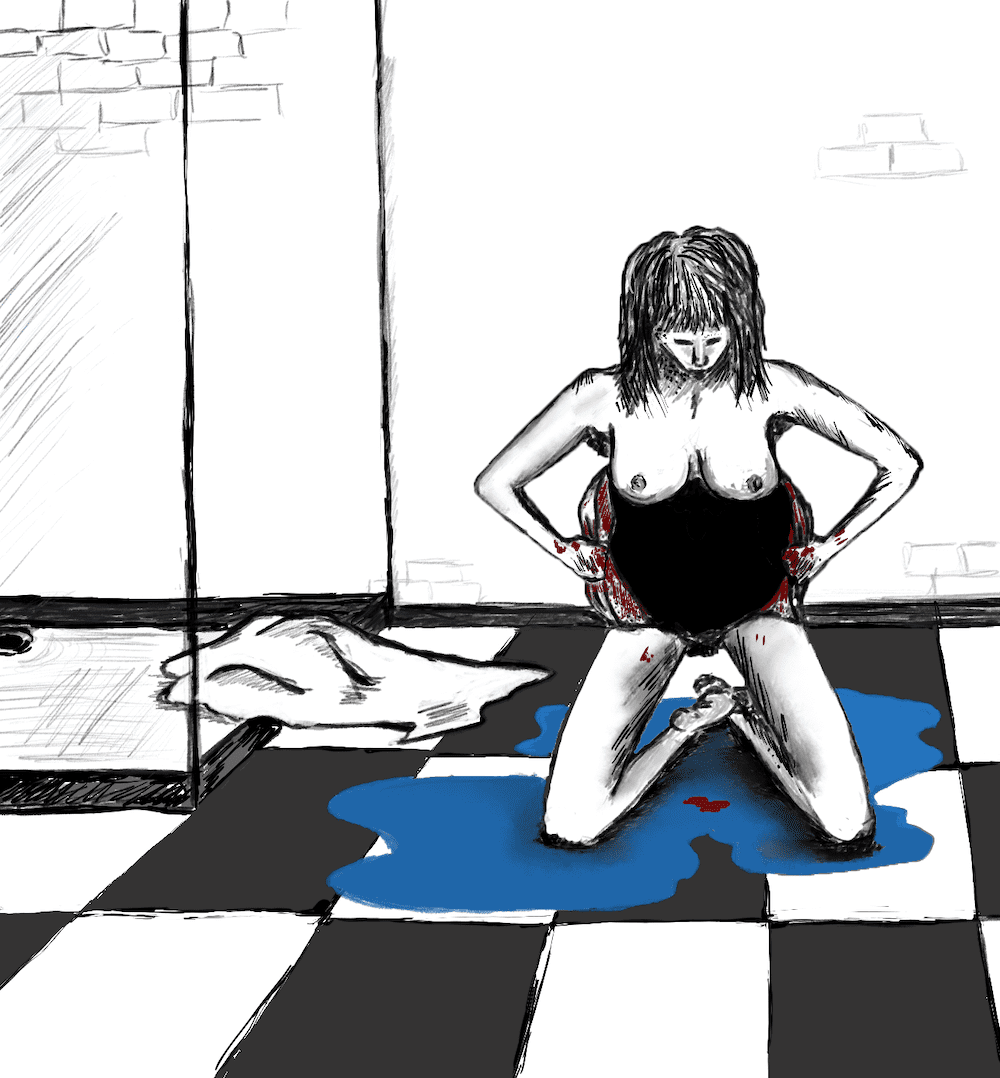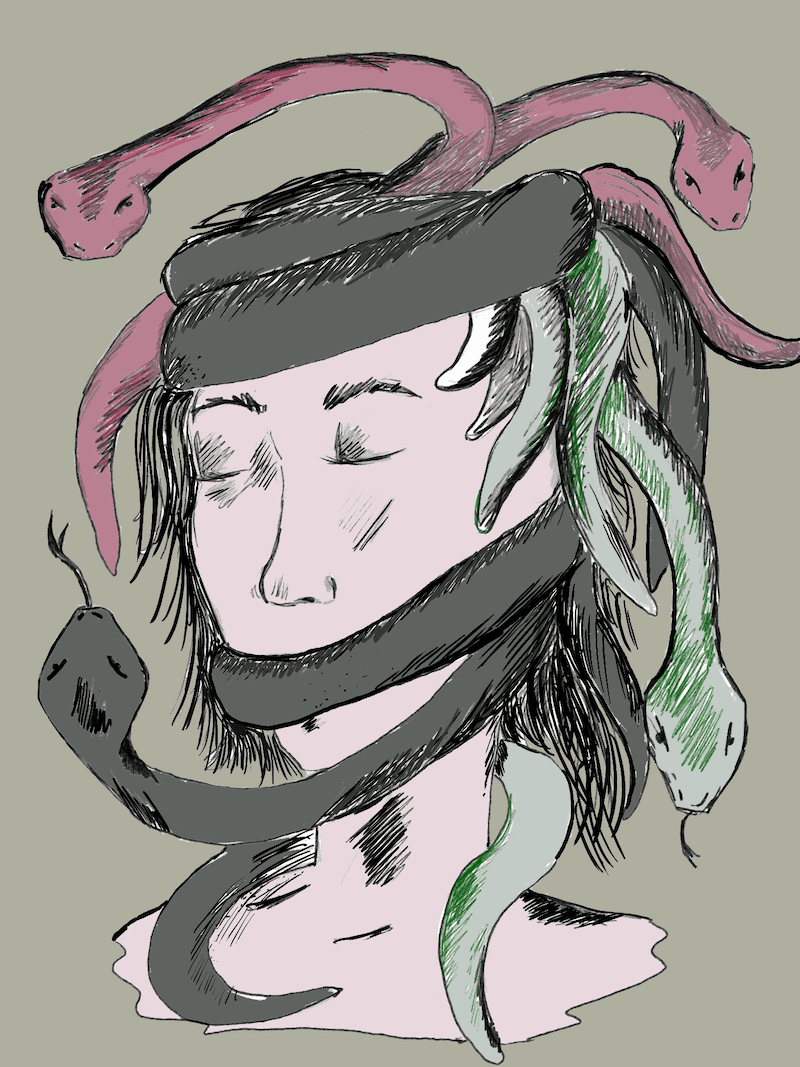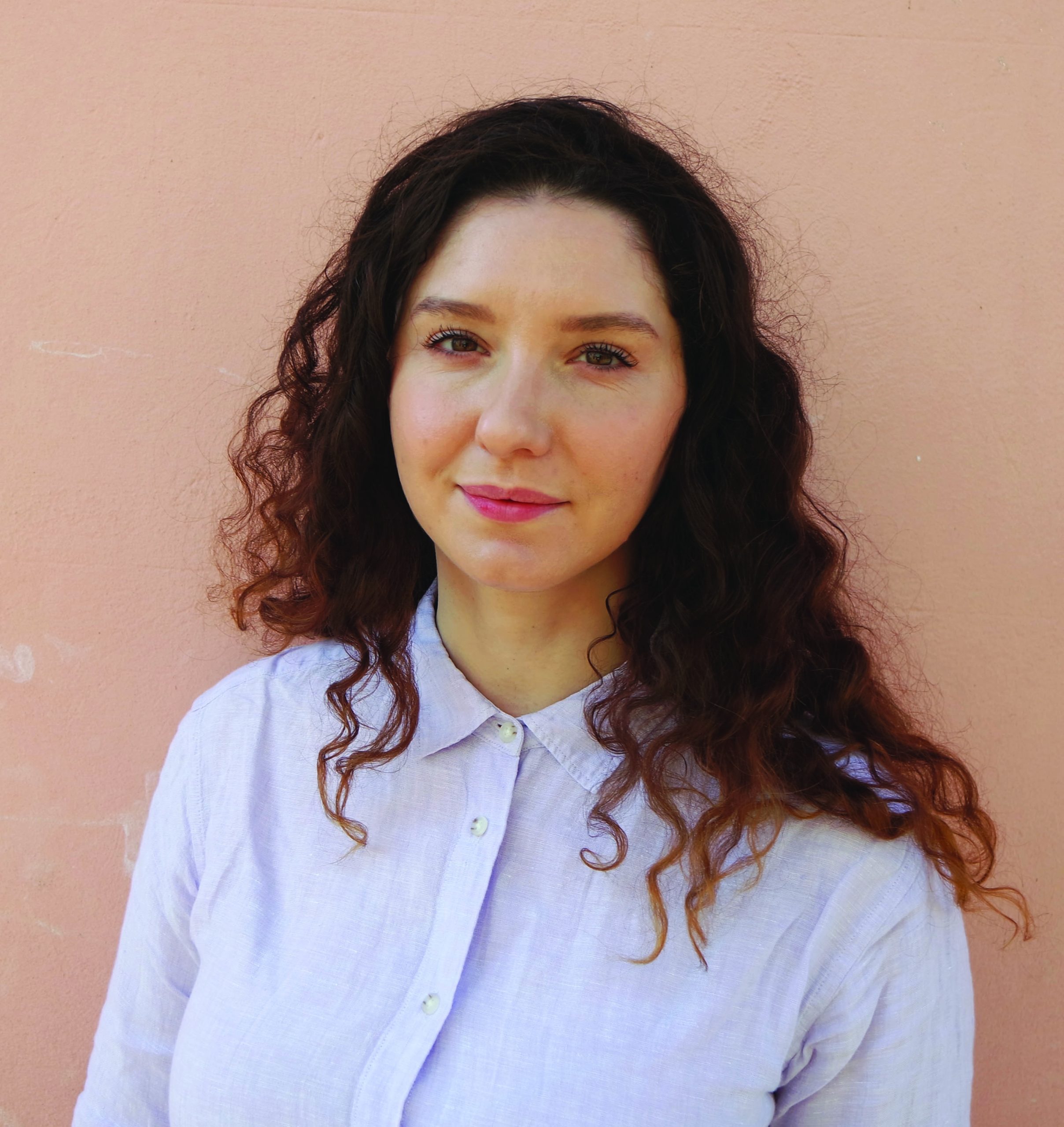I grew up in a town nestled at the base of two peninsulas. At night, my friends and I drove out of city limits and onto the limbs of the land, reaching around our bay, whose blue was hidden in the darkness. Out there was the best spot to look at the stars: the top of a hill, giving us a 360-degree view of grape vines and cherry trees, water stretching out black on three sides. On a clear night, we could see a band of star clusters and dust lanes heading toward the core of our galaxy, looking like someone up there had tripped over a bunch of stars and shattered them. On a cold night, every point of light looked like a dagger. I’d take a deep breath and wait for a star to puncture the atmosphere and fall burning to my feet.
The 1960s was a time for the avant-garde, brought about by shifting attitudes toward tradition and the limitations that it carries with it. In France, these shifting attitudes’ heavily affected the art world, leading art critic Pierre Restany to dub the period “Nouveau Réalisme.” New Realism. These artists didn’t want their art to reflect reality; they wanted to appropriate a reality created by an industrial and consumerist society, restructuring already existing images to reflect an emotional state often unexpressed. To accomplish this, artists focused on collage and assemblage techniques to include external objects in their created realities, and pioneered “décollage,” collage’s opposite, tearing apart posters and decontextualizing advertisements from their product. Anything to strip mass production of its dominance; an attempt to return to one human looking at another and seeing their body—made of many parts, but whole.
In Bermuda, there are fossilized beaches from before our last ice age, fields of black coral hidden far beneath human reach. Thus far scientific explorations in the area have identified twelve separate species of coral have found twenty-eight new species, beginning the human process of naming then destroying. The shallower waters nearby are already choked with coral bleached from rising temperatures, a global trend that’s changing how the ocean breathes itself from CO2 to oxygen and back. As a result, oxygen levels in the ocean are decreasing. Scientists that specialize in deep-sea research are concerned that without proper investment in understanding the creatures living so far below us we can’t predict our impact on our environment, and therefore we cannot predict our future on this planet.
1973 brought Immoral Tales to the screen, a French film sometimes labeled softcore porn, sometimes labeled film, and sometimes simply described as erotic stories. The movie presents carefully curated images of sexuality: body parts isolated in the frame and grand backdrops. The first story shows a boy beckoning a girl from the water, her bare feet stumbling over a rocky beach. There is the sound of gulls, and he presses her to her knees. The rocks clack together as they roll. The boy explains tides to her as water rises to their faces.
During an adolescent summer, I signed up for a math and science camp not because I wanted to be a scientist but because I loved to learn about questions humans didn’t know the answers to. I was a weird kid at a camp of weird kids, and I was too unsure in my weirdness to be anything but off-putting. I felt like a planet in gravitational confusion, spinning between different groups of friends, and my feelings of misalignment heightened by how summer was always pressing into my body. Every day, I had to push the discomfort of shorts and sticky shirts to the back of my mind until I got to the darkened lecture hall where my astronomy class was held. With only ten of us in a room built for two hundred, it could have been that we were also floating somewhere else, with different gravity. I watched rapid-fire PowerPoint presentations of emission nebula, reflection nebula, supernova remnants, and imagined a great and dark world populated by painted, angel-filled skies created by combustion and dust. The discomfort of living in a body with such strict endings and beginnings, such static shape, dulled when I turned my head upwards, towards celestial figures, where I could swim in red oceans, in tides of dust.
A pioneering artist of Nouveau Réalisme, Yves Klein was obsessed with the void. He wanted to dive into the monotone of nothing, and so he pulled stunts to confuse art critics, like emptying a gallery of all furniture and art as his exhibit. He liked the idea of the endless nothing that has always existed and will continue to exist far after even he was gone. But the man couldn’t help but try to brand the void in his name. He created the color of his empty, his own concoction called International Klein Blue, made with striking ultramarine pigment. However, the pigment is not the origin of its brilliance; it is the synthetic resin binder that the pigment is suspended in. As a result, the color maintained abnormal intensity. In 1958, Klein’s art no longer just included blue, it became blue. He painted canvases in his color, the blue that was a manifestation of freedom, a cosmic visual that stretches as far away as our eyes are able to see.
We have made little suns, millions of them, to screw into walls and chase away the dark. We want no unlit corners gathering what we’d rather not see. At the expense of night, we keep turning on our lights. Lamps interrupt amphibians’ nocturnal breeding songs, throwing off chords communicating reproduction. Every year, millions of birds fly into the windows of illuminated buildings, unable to navigate by moonlight with so much reflection. Freshly hatched turtles are led to the false horizon by artificial light.
It was middle school when I noticed my body and my friends’ bodies were curved, like vases on display at a garage sale. Some of us went out and in and out again, others rounded past their hips, some remained fairly straight. I became endlessly focused on the lines of my own body, specifically the space by my hips. I wanted there to be a swell of hip bone, instead of the flesh of my stomach, and a dip inwards before my legs. On the flecked tile of our middle school cafeteria, some girls ate in careful, slow bites but I was always hungry. I couldn’t bring myself to eat less, even as I watched my friends throw away half-full containers and cut carbs “just to see if they could.” I remember a day I was determined not to eat, and how quickly my stomach dissolved into storm-like grumbling. By the end of the day, I had cramps so intense I bent over on the grassy backyard of our Girl Scouts leader’s house while the other girls were searching for morel mushrooms in the woods.
The black coral that populates the water around Bermuda also finds its home in most tropical areas. While their communities are called forests, they are not trees or even plants at all, but in fact the same as us—Animalia. Covered in small thorn-like polyps, the coral was once believed to ward off evil and injury, and its Latin name, Antipharia, finds its roots in “against suffering.” However, what we call black coral never exists in life as we have named it; only the coral’s skeleton is black. When it is alive, its tissue is heavily saturated in reds, oranges, and greens—but it is its black skeleton that is sought out for its popularity in jewelry-making.
My first year of college: my friend and I sat on her dorm room floor with boxed wine and an Iowa-specific liquor named Hawkeye, a vodka-flavored grain alcohol. Her dorm always smelled like cigarettes, mildew, and sweat boiled over a stove, which was less of her own scent than what was left in the walls after years and years of housing melancholy nineteen-year-olds. We swayed in front of her laptop as an episode of Freaks and Geeks played, indulging in a drinking game that didn’t really have any rules beyond declaring a toast to moments of recalled 90s angst. It was the last day of our first semester, and we had chosen to stay out all night before getting on the bus to Chicago early in the morning. While we sat on the floor, people came from down the hall to talk or participate for a while, soberly sitting on the beds while we sprawled across the floor. I didn’t imagine myself as an exhibit, but if you would have put glass around my friend and me, we’d surely have been labeled some kind of biological phenomenon. A Latin name for two drunk girls trying to forget what happens next. When I walked home to grab my suitcase it was dark and quiet and the air was so cold it felt like broken glass.
Nouveau Réalisme helped fuel a global trend in body art, rising in popularity with French artists as well as with performance artists in the States. It was still the 1960s after all, the era of free love and psychedelics; it makes sense that during the era of the body on display, art made the body the display. Connecting the techniques of collage and décollage, artists incorporated their physicality into a constructed piece, whether as actor, stage, canvas, or medium, to create a heightened reality. By including their body in the work, these acts of art were inseparable from the artist. In the shadow of the draft, US body artists became obsessed with the human cost of war, connecting the attack of the US military on the bodies of the Vietnamese people to the violent suppression of peace activists putting their bodies on the line.
When I lived in Iowa, I knew where something began and where it ended. Now I try to find the same order—an end before a beginning—but in the metro during rush hour all the bodies crowded together give off a cloud of heat that makes my head spin. I have to count the non-humans I cross: a beetle whose back reflects the sky, rats in yellow-tinged alleyways dragging their stomachs on the ground, flowers bouncing upwards when the bumblebees jump from their petals. Gentle stories of hunger and filling and hunger again, no different from the way a sprawl of trees live but now washed in concrete grey. In the Midwest, I could find delineation between the environment and my body, so treacherously human in its box-spring bed. Now lost in the midst of a city’s grid system, I feel fear along the sides; I am always scanning the periphery for quick movements and potential predators. I’m still dreaming of the precise color of pink that I’ve only ever seen in Iowa skies, approximately 7:30 p.m. in the evening, a sky so soft you forget its air is touching your skin. Sky so soft it settles into night like the smallest exhale of breath. A friend and I pause our conversations to listen to the sounds of the train, metal against metal, a warning call. The town unrolls like a carpet and ends just as suddenly. A body, discreet.
I did the things you are supposed to do to stay safe, as any woman does. Keys between fingers, shoes I can run in, no sleeping with strangers, watch my friends’ drinks, watch my own drink. They work until they don’t. These nights I know my body doesn’t end. It is unspooled, spread across bed sheets, looking at itself in the mirror and trying to find something familiar in the shape of its face.
Before the fossilized beaches and their forests were found in Bermuda, Italian biologists discovered the largest settlement of black coral in the world. Almost thirty-thousand colonies were found in a narrow passage called the Strait of Messina, the same waters that housed the monsters Scylla and Charybdis in myth, famously described by Homer in the Odyssey as a snake-like monster with six heads and a swallowing whirlpool, respectively. While Homer never mentions any sprawling animalistic forests, ancient authors often assumed the Mediterranean sea was home to deep-sea monsters, creating stories from the accounts of local fisherman who described giant eels and octopuses attacking ships. I imagine these monsters were more terrified by the billowing wings of ancient sails, forcing their retreat to their black-coral forests where humans couldn’t reach them.
Sitting on the shower’s floor, I use my hands to guide the vomit-and-water mix toward the drain. I make a mental note that next time the toilet would be better, a cleaner aftermath. But the shower provides more sound cover; the faucet might not be enough to prevent my roommate from hearing the involuntary noises that, even after a year of practice, I can’t stifle. I hadn’t purged in months but it still felt familiar. The next morning I shimmered, unable to eat or talk because I was somewhere alien, nonhuman.
How many times have women been just a body? How many times have judges seen the long path of a man’s life stretched out before him and a woman as merely a vessel, for blood or sex or sin? How are we supposed to care for our bodies when we are left without a past or a future and instead given a heavy pile of flesh whose only value is how good it feels in the hands of men?
Charybdis is never given a body. In the Odyssey, she is only visually represented as a violent spiral of water, her hunger so expansive it drank the ocean and whatever rode it. Scylla was given two bodies; before her six heads and endless rows of teeth, she was a beautiful woman. Her transformation into monstrosity is a result of bad fortune: a man asks sorceress Circe for a love potion to give to Scylla, but Circe falls in love with the man upon sight. When he refuses her, she gives him a potion that, instead of inciting love, turns Scylla into a man-eating monster.
Yves Klein painted the naked bodies of women models in his famous blue and had them press and drag themselves against canvas at his instruction. He called them his “living brushes.” He no longer had to cover himself with smocks or wash paint from his fingernails. He just had to tell bodies where to go, how to move, wait as they left bright color in their wake. “I no longer dirtied myself with color, not even the tips of my fingers,” Klein said of the project.
I don’t want sex. I just want a hand sliding up my thigh.
While it was happening, I described purging with the same words I once described church. It reminded me of my discomfort during prayer. I had been taught the technicalities of the activity, I knew I should feel something, but there was only the twinkling of stained glass and dust motes defying gravity. My spirituality was found swimming in the lake by my house. The movement of the water on my skin mirrored the endless slipping I felt inside myself, currents of thought that spit and swirled and refused to solidify. As I got older I found other avenues to fluidity, and nothing was so uncontrollably liquid as pressing my kneecaps into the thinned bathmat, the cold of the tiled floor only a small barrier away. There was power in making my body struggle. It refused to be small and pristine and unwanting, and so I would train it harshly, without care or empathy.
Scylla is not the only beautiful woman to become a monster. Medusa is given a similar fate. It is said that when Medusa was human she was a priestess of Athena. One day, Poseidon sees Medusa and is so overcome with desire he fucks her on the floors of Athena’s temple. As punishment for betraying her vows to Athena, the goddess changes Medusa into a horrible monster who would never again feel the touch of a man—for as soon as they got close enough to look into her eyes, she would only feel fingers of stone.
What if sex is the quickest way to remove all our hardened layers? Our way to spin out of whatever gravitational field we have spun within, alone, for so long? What if someone kissed me and I could feel something besides the nausea that still rises in my stomach like clouds rising on the horizon?
In 1975, body artist Carolee Schneemann undressed in front of an audience, primarily women, and then started to pull a scroll from her vagina, reading its text aloud. Schneemann, years later, wrote that “I didn’t want to pull a scroll out of my vagina and read it in public, but the culture’s terror of my making overt what it wished to suppress fueled the image.”
I can’t exactly articulate why I purged, but I know it had something to do with hunger. I was so hungry, and nothing I ate satisfied me. When I was full, it was only of food, and I had to admit that that was never what my hunger wanted. All I could do was beg my emptiness to take me back. It was a necessary evil; it was both punishment and solution. It was horrific; it was the most beautiful high I’ve ever had. I feel sure, now that I can slap on the “recovered” label and let the sharpness of my memories wear themselves round, that these things are true—but it’s hard to say. My brain has clouded the worst of it. This may be kind, but I am not so recovered that I want this kindness. I want every bright moment alone in a bathroom. I want the memory of acid poised in the back of my throat. I want ownership over my body and its memories, no matter how much cruelty results. It’s not that I miss purging. I don’t. But at least during that time in my life, I was the one choosing how my body was touched. Whether it was given kindness or punishment.
A different reading of Medusa’s origin story: Athena transformed her priestess to save her from a hell that would never end for such a beautiful woman. After Poseidon raped Medusa on the floors of the temple she worshipped in, Athena turned her into a woman that was so powerful no man would ever be able to touch her again.
I eat very little now, due to certain medications and the memories of scratches on the inside of my mouth. Once my hunger was chased away by prescriptions, I realized how little I wanted food. The cold light of the refrigerator makes my hairs stand on end, as if in protest, and while I feel the empty growing larger and larger I want nothing. This is as frightening as growing bigger: becoming small like I would soon raisin into a different body. In either instance my body doesn’t belong to me, but to whatever kind of hunger is most powerful at the moment. Do I want to be hollow or overflowing tonight? I can’t stop pride from sneaking in when I count how many hours since I last ate, when my stomach feels concave. A dream come true: a girl once ruled by binge eating finally transforms into the girl pushing almonds around her plate in protest of a body that refuses to end.
Yves Klein’s void killed him. The resin that gave his paint its brilliance was also toxic, and made it difficult for those that regularly encountered it to breathe. After years of breathing in his void, Yves Klein died of a related heart attack. No one mentions the lungs of his living brushes, whether the women who left his studio felt short of breath.
All I want is to feed myself like a person who wants to be fed.
***
Rumpus original art by Lisa Marie Forde.
***
If you or someone you know is struggling with disordered eating and other self-harming behaviors we urge you to seek treatment. Crisis Text Line offers free, 24/7 support. Text 741741 from anywhere in the US to text with a trained Crisis Counselor. NEDA is an eating-disorder specific organization with a helpline you can reach by calling (800) 931-2237. – Ed.
